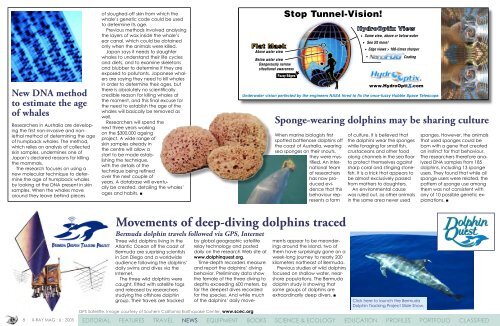Medium resolution version of X-Ray Magazine (96 dpi)
Medium resolution version of X-Ray Magazine (96 dpi)
Medium resolution version of X-Ray Magazine (96 dpi)
You also want an ePaper? Increase the reach of your titles
YUMPU automatically turns print PDFs into web optimized ePapers that Google loves.
New DNA method<br />
to estimate the age<br />
<strong>of</strong> whales<br />
Researchers in Australia are developing<br />
the first non-invasive and nonlethal<br />
method <strong>of</strong> determining the age<br />
<strong>of</strong> humpback whales. The method,<br />
which relies on analysis <strong>of</strong> collected<br />
skin samples, undermines one <strong>of</strong><br />
Japan’s declared reasons for killing<br />
the mammals.<br />
The research focuses on using a<br />
new molecular technique to determine<br />
the age <strong>of</strong> humpback whales<br />
by looking at the DNA present in skin<br />
samples. When the whales move<br />
around they leave behind pieces<br />
<strong>of</strong> sloughed-<strong>of</strong>f skin from which the<br />
whale’s genetic code could be used<br />
to determine its age.<br />
Previous methods involved analysing<br />
the layers <strong>of</strong> wax inside the whale’s<br />
ear canal, which could be obtained<br />
only when the animals were killed.<br />
Japan says it needs to slaughter<br />
whales to understand their life cycles<br />
and diets, and to examine skeletons<br />
and blubber to determine if they are<br />
exposed to pollutants. Japanese whalers<br />
are saying they need to kill whales<br />
in order to determine their ages, but<br />
there is absolutely no scientifically<br />
credible reason for killing whales at<br />
the moment, and this final excuse for<br />
the need to establish the age <strong>of</strong> the<br />
whales will basically be removed as<br />
well.<br />
Researchers will spend the<br />
next three years working<br />
on the $300,000 ageing<br />
project. A wide range <strong>of</strong><br />
skin samples already in<br />
the centre will allow a<br />
start to be made establishing<br />
the technique,<br />
with the details <strong>of</strong> the<br />
technique being refined<br />
over the next couple <strong>of</strong><br />
years. A database will eventually<br />
be created, detailing the whales’<br />
ages and habits. ■<br />
<br />
<br />
<br />
<br />
<br />
<br />
<br />
<br />
<br />
<br />
<br />
<br />
<br />
<br />
Sponge-wearing dolphins may be sharing culture<br />
When marine biologists first<br />
spotted bottlenose dolphins <strong>of</strong>f<br />
the coast <strong>of</strong> Australia, wearing<br />
sea sponges on their snouts,<br />
they were mystified.<br />
An international<br />
team<br />
<strong>of</strong> researchers<br />
has now produced<br />
evidence<br />
that this<br />
behaviour represents<br />
a form<br />
<strong>of</strong> culture. It is believed that<br />
the dolphins wear the sponges<br />
while foraging for small fish,<br />
crustaceans and other food<br />
along channels in the sea floor<br />
to protect themselves against<br />
sharp coral and stinging stonefish.<br />
It is a trick that appears to<br />
be almost exclusively passed<br />
from mothers to daughters.<br />
An environmental cause<br />
was ruled out, as other animals<br />
in the same area never used<br />
sponges. However, the animals<br />
that used sponges could be<br />
born with a gene that created<br />
an instinct for that behaviour.<br />
The researchers therefore analyzed<br />
DNA samples from 185<br />
dolphins, including 13 sponge<br />
users. They found that while all<br />
sponge users were related, the<br />
pattern <strong>of</strong> sponge use among<br />
them was not consistent with<br />
any <strong>of</strong> 10 possible genetic explanations.<br />
■<br />
Movements <strong>of</strong> deep-diving dolphins traced<br />
Bermuda dolphin travels followed via GPS, Internet<br />
Three wild dolphins living in the<br />
Atlantic Ocean <strong>of</strong>f the coast <strong>of</strong><br />
Bermuda are surprising scientists<br />
in San Diego and a worldwide<br />
audience following the dolphins’<br />
daily swims and dives via the<br />
Internet.<br />
The three wild dolphins were<br />
caught, fitted with satellite tags<br />
and released by researchers<br />
studying the <strong>of</strong>fshore dolphin<br />
group. Their travels are tracked<br />
GPS Satelitte. Image courtesy <strong>of</strong> Souhern California Earthquake Center, www.scec.org<br />
by global geographic satellite<br />
relay technology and posted<br />
daily on the research Web site at<br />
www.dolphinquest.org.<br />
Time-depth recorders measure<br />
and report the dolphins’ diving<br />
behavior. Preliminary data show<br />
the female <strong>of</strong> the three diving to<br />
depths exceeding 600 meters, by<br />
far the deepest dives recorded<br />
for the species. And while much<br />
<strong>of</strong> the dolphins’ daily movements<br />
appear to be meanderings<br />
around the island, two <strong>of</strong><br />
them have surprisingly gone on a<br />
week-long journey to nearly 200<br />
kilometers northeast <strong>of</strong> Bermuda.<br />
Previous studies <strong>of</strong> wild dolphins<br />
focused on shallow water, nearshore<br />
populations. The Bermuda<br />
dolphin study is showing that<br />
some groups <strong>of</strong> dolphins are<br />
extraordinarily deep divers. ■<br />
Click here to launch the Bermuda<br />
Dolphin Tracking Project Slide Show.<br />
8 X-RAY MAG : 6 : 2005 EDITORIAL FEATURES TRAVEL NEWS EQUIPMENT BOOKS SCIENCE & ECOLOGY EDUCATION PROFILES PORTFOLIO CLASSIFIED
















